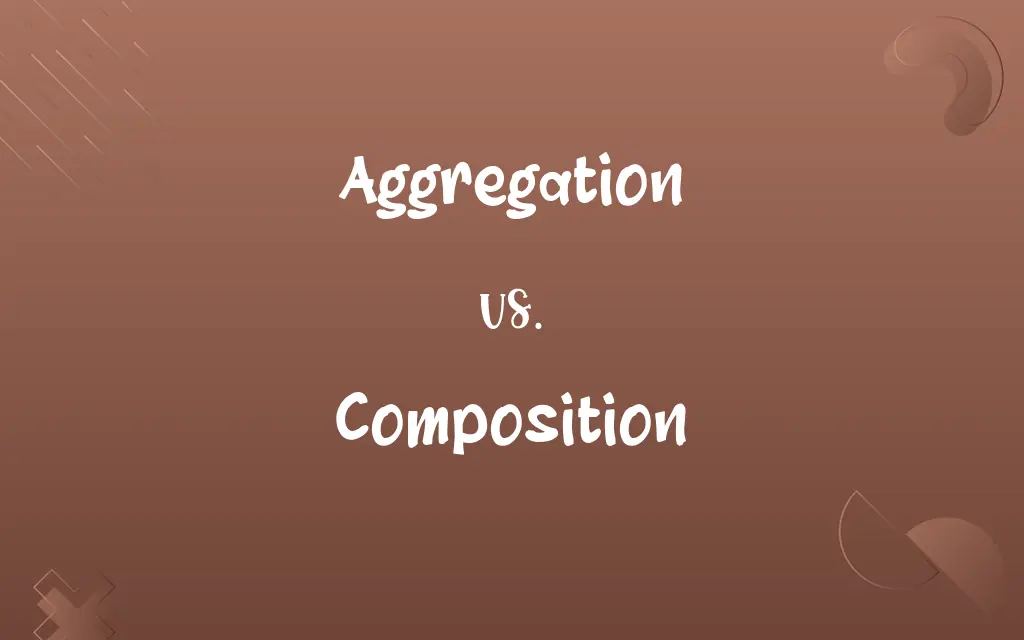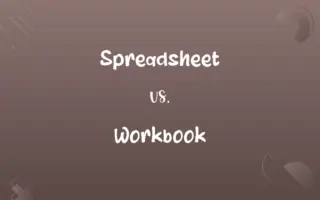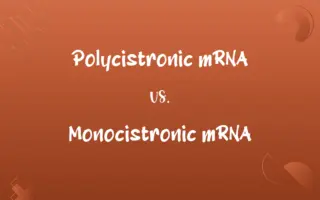Aggregation vs. Composition: Know the Difference

By Shumaila Saeed & Dua Fatima || Published on March 2, 2024
Aggregation is a weak association without exclusive ownership; composition is a strong, exclusive ownership relationship with coinciding lifecycles.

Key Differences
Aggregation represents a relationship where the child can exist independently of the parent, suggesting a "has-a" relationship but with shared ownership. Composition, on the other hand, signifies a stronger relationship where the child's lifecycle is strictly bound to the parent's lifecycle.
Shumaila Saeed
Mar 02, 2024
Aggregation allows for shared resources, and the destruction of the parent does not necessarily affect the existence of child objects. This relationship is typically used to represent situations where objects form a part of a whole, but can also belong to other groups or wholes simultaneously. Composition, "part-of" relationship dictates that if the parent object is destroyed, its composed child objects will also be destroyed. Composition implies exclusive ownership over the composed objects, making it suitable for representing situations where parts cannot exist without the whole.
Dua Fatima
Mar 02, 2024
The distinction also reflects in their flexibility and use: aggregation is used for relationships that require shared or non-exclusive ownership, promoting reuse and independence among objects. Composition is chosen for more closely knit relationships where components are inherently linked to their parent object, emphasizing dependency and unity.
Shumaila Saeed
Mar 02, 2024
Aggregation and Composition depends on the required lifespan and ownership of the involved objects. Aggregation is applied when linking objects that can logically exist apart, while composition is reserved for relationships where objects are intrinsically connected to their parent object’s existence.
Dua Fatima
Mar 02, 2024
The implications for object management and design patterns are significant: aggregation allows for more flexible and decoupled object designs, facilitating easier modification and extension. Composition, by fostering strong dependencies, ensures a more controlled environment, where the state and lifecycle of the whole and its parts are tightly coupled.
Shumaila Saeed
Mar 02, 2024
ADVERTISEMENT
Comparison Chart
Lifecycle
Child objects can exist independently of the parent.
Child objects' lifecycles are bound to the parent's lifecycle.
Shumaila Saeed
Mar 02, 2024
Relationship Type
"Has-a" relationship, indicating a broader association.
"Part-of" relationship, indicating a stronger, dependent association.
Dua Fatima
Mar 02, 2024
Object Independence
High; child objects can associate with multiple parents.
Low; child objects are dependent on the parent.
Shumaila Saeed
Mar 02, 2024
Use Case
Suitable for less closely related objects and shared resources.
Suitable for closely related objects where parts do not logically exist without the whole.
Shumaila Saeed
Mar 02, 2024
ADVERTISEMENT
Aggregation and Composition Definitions
Aggregation
Indicates a broader "has-a" association without strict dependency.
A car and a steering wheel - the car can exist without this specific steering wheel.
Dua Fatima
Feb 26, 2024
Composition
Ensures child objects are destroyed with the parent.
Deleting a tree also deletes its branches.
Shumaila Saeed
Feb 26, 2024
Aggregation
Allows objects to remain independent and reusable.
A person and a job - a person can change jobs without ceasing to exist.
Shumaila Saeed
Feb 26, 2024
Composition
Enforces dependency between the whole and its parts.
A body and its heart - the heart cannot exist without the body.
Dua Fatima
Feb 26, 2024
Aggregation
Facilitates shared ownership among objects.
Multiple libraries sharing a single book.
Shumaila Saeed
Feb 26, 2024
ADVERTISEMENT
Composition
A relationship where the child's existence is tied to the parent's lifecycle.
A house and rooms - rooms don't exist without the house.
Dua Fatima
Feb 26, 2024
Aggregation
A represents a relationship where a child can exist separately from the parent.
A library and books - books can exist outside the library.
Dua Fatima
Feb 26, 2024
Composition
Implies a strong "part-of" association with exclusive ownership.
An engine in a car - the engine is integral to the car.
Shumaila Saeed
Feb 26, 2024
Aggregation
Suits scenarios with non-exclusive associations.
A shopping cart and products - products can be in multiple carts.
Dua Fatima
Feb 26, 2024
Composition
Ideal for closely related objects forming a cohesive unit.
A company and its departments - departments are fundamental parts of the company.
Dua Fatima
Feb 26, 2024
Repeatedly Asked Queries
What is aggregation in object-oriented programming?
Aggregation is a relationship where a child object can exist independently of the parent, indicating a "has-a" relationship with shared or non-exclusive ownership.
Dua Fatima
Mar 02, 2024
Why choose aggregation over composition?
Aggregation is chosen for more flexible and less dependent associations, where objects have shared ownership or can logically exist separately.
Shumaila Saeed
Mar 02, 2024
What is composition in object-oriented programming?
Composition is a strong association where the child's lifecycle is tightly coupled with the parent's, embodying a "part-of" relationship with exclusive ownership.
Shumaila Saeed
Mar 02, 2024
How do aggregation and composition differ in terms of object lifecycle?
In aggregation, child objects can outlive the parent object, while in composition, child objects' lifecycles are dependent on the parent's existence.
Dua Fatima
Mar 02, 2024
Can an object be part of both an aggregation and composition relationship?
Yes, an object can participate in both relationships, but in different contexts, reflecting the flexibility of object-oriented design.
Hifza Nasir
Mar 02, 2024
Why choose composition over aggregation?
Composition is selected for relationships where components are inherently linked to their parent, ensuring a unified lifecycle and exclusive ownership.
Dua Fatima
Mar 02, 2024
How does aggregation affect object design?
Aggregation promotes decoupled designs, making objects more independent, reusable, and adaptable to changes.
Hifza Nasir
Mar 02, 2024
How does composition affect object design?
Composition encourages tightly coupled designs, where the whole and its parts are closely knit, enhancing coherence and integrity within the system.
Dua Fatima
Mar 02, 2024
What are some practical examples of aggregation and composition?
The example of aggregation is a university and its students, where students can also attend other institutions. and the example of composition is computer and its motherboard, where the motherboard is essential and exclusive to the computer.
Dua Fatima
Mar 02, 2024
Can aggregation and composition be used together?
Yes, they can be used together in a system to accurately model complex relationships between objects, balancing flexibility and dependency.
Dua Fatima
Mar 02, 2024
Share this page
Link for your blog / website
HTML
Link to share via messenger
About Author
Written by
Shumaila SaeedShumaila Saeed, an expert content creator with 6 years of experience, specializes in distilling complex topics into easily digestible comparisons, shining a light on the nuances that both inform and educate readers with clarity and accuracy.
Co-written by
Dua Fatima







































































